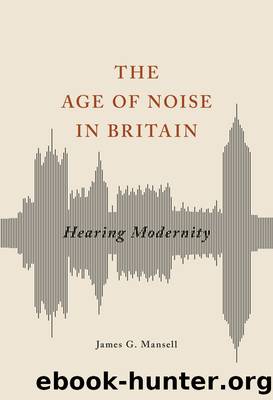The Age of Noise in Britain by Mansell James G.;

Author:Mansell, James G.;
Language: eng
Format: epub
Publisher: University of Illinois Press
Published: 2016-07-14T16:00:00+00:00
FIGURE 3.1 Advert for the Underwood Noiseless Typewriter in Noise Abatement Exhibition: Science Museum, South Kensington, 31st May–30th June 1935 (London: Anti-Noise League, 1935), 75.
FIGURE 3.2 Advert for Newalls Insulation Company in Noise Abatement Exhibition: Science Museum, South Kensington, 31st May–30th June 1935 (London: Anti-Noise League, 1935), 76.
Privacy, Interiority, and the Meanings of Home
The workplace was not the only site of state intervention in everyday aurality. The home, too, was the subject of expert knowledge-gathering in this period. As well as setting the stage for government interest in the psychological effects of workplace noise, the First World War was also the catalyst for a shift toward state intervention in housing, which included, as one of its core principles, an attempt to perfect ideal sonic conditions for domestic life. New home building ground to a halt in the wartime conditions of 1914–1915 and rents rose considerably as a result. Under pressure to take action, the government stepped in to control prices.83 Having made this initial move toward central regulation, momentum grew in support of greater state responsibility. “Homes fit for heroes” proved to be a popular rallying cry at the end of the war and, in response, the 1919 Housing Act set in motion the construction of a million local authority-owned council homes and a further three million private houses in the period to 1938.84 It was hoped that a new role for the state in directing this activity would ensure a rational approach to home building in contrast to the profit-driven haste of Victorian urban development. The government established the Building Research Station (BRS) as a branch of the Department of Industrial and Scientific Research in 1920. It was tasked with establishing rational principles for home building and disseminated its findings to local authorities, architects, and the building industry via regular bulletins. The modernist ethos of rational state-led planning was embodied in the BRS and its sister organization, the National Physical Laboratory (NPL). Among other projects, these two bodies cooperated in producing detailed scientific research about sound in the home, facilitating, as the IHRB did in the case of industrial psychology, the growth of the new discipline of architectural acoustics.85
At the heart of these organizations’ work was a guiding principle: the home, irrespective of the social class of its occupants, should provide a private, quiet, sanctuary from the sounds of the outside world. While adaptation to rhythmic noise was classified as the norm in the industrial workplace, in the case of the home the threat posed by environmental and neighbor noise was taken altogether more seriously as a threat to mental health. After all, periods of rest away from the rhythms of the workplace were part of the wider rhythmical logic of the working week. Noise, in the domestic con-text, meant disruption to the rhythm of rest. Quietness at home was thus constructed as part of the normative rhythmic operation of everyday sonic life. The greater interest in soundproofing the home in comparison to the dismissal of the need to
Download
This site does not store any files on its server. We only index and link to content provided by other sites. Please contact the content providers to delete copyright contents if any and email us, we'll remove relevant links or contents immediately.
| Africa | Americas |
| Arctic & Antarctica | Asia |
| Australia & Oceania | Europe |
| Middle East | Russia |
| United States | World |
| Ancient Civilizations | Military |
| Historical Study & Educational Resources |
Underground: A Human History of the Worlds Beneath Our Feet by Will Hunt(12022)
Sapiens by Yuval Noah Harari(5293)
Navigation and Map Reading by K Andrew(5111)
The Sympathizer by Viet Thanh Nguyen(4305)
Barron's AP Biology by Goldberg M.S. Deborah T(4096)
5 Steps to a 5 AP U.S. History, 2010-2011 Edition (5 Steps to a 5 on the Advanced Placement Examinations Series) by Armstrong Stephen(3687)
Three Women by Lisa Taddeo(3353)
Water by Ian Miller(3126)
The Comedians: Drunks, Thieves, Scoundrels, and the History of American Comedy by Nesteroff Kliph(3039)
Drugs Unlimited by Mike Power(2544)
A Short History of Drunkenness by Forsyth Mark(2233)
DarkMarket by Misha Glenny(2158)
The House of Government by Slezkine Yuri(2158)
And the Band Played On by Randy Shilts(2127)
The Library Book by Susan Orlean(2041)
Revived (Cat Patrick) by Cat Patrick(1963)
The Woman Who Smashed Codes by Jason Fagone(1929)
Birth by Tina Cassidy(1864)
The Absolutely True Diary of a Part-Time Indian by Sherman Alexie(1855)
